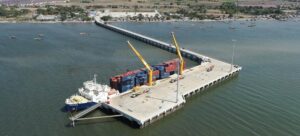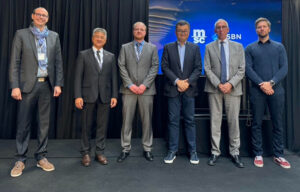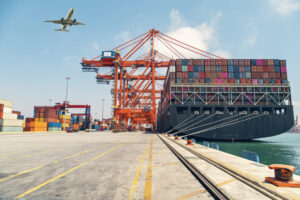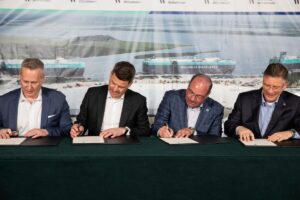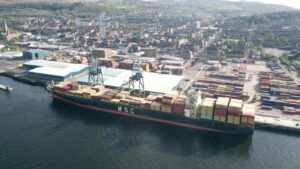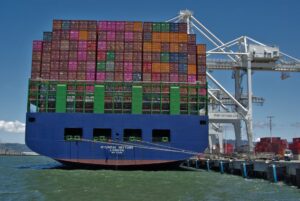The Port of Esbjerg is perfectly-sized to take on ambitious digitalisation projects that can be a lighthouse for players in maritime.
Serving a variety of functions ranging from container to ro-ro cargo, handling 4.3 million tons in 2019, its smaller size compared to major neighbours like Hamburg and Gothenburg allows the port to be agile in its digital policy, says Jesper Bank, COO, Port of Esbjerg.
“Port Esbjerg has exactly the size where it can be a case port,” Bank told PTI. “Because we are big enough to have a very small but full-scale value chain, it’s easy for us to go to companies and say: ‘Here is a concept. We have thought about your business; we have thought about your vessels, we know your employees, we know where you are and the resources you have.’”
Jesper will be speaking at PTI’s Container Automation Conference 2021 on 18-21 May. Click here to register!
Delivering carbon reduction with Honeywell
One digitalisation initiative the port is embarking on is the reduction of carbon emissions through real-time monitoring with Honeywell.
Through the cloud-based Honeywell Enacto Carbon and Energy Management system, the port monitors and pinpoints resource consumption of every user and the variety of sensors and energy gauges at the port.
Bank and his team have access to real-time information of the carbon emissions of the port and can make actionable decisions from them.
“With a high level of data floating around in maritime logistics, you are able to access data on each vessel: what kind of fuel, in what kind of engine,” he explained.
“We can integrate this right away with the Honeywell system, and boom: you have the CO2 emission calculations. We can identify ‘red’ areas of the port where CO2 emissions are high in the area may be very close to the city boundaries.
“So, we can make the decision whether to put to shoreside power here, or should we instead take some vessel traffic and put in another part of the port? All of these decisions are now based on the data.”
Through the Honeywell system and its Artificial Intelligence (AI) in conjunction with data collection, if energy consumption from vessels using the ports changes significantly, port operatives are alerted and can respond in real time.
The data has also allowed the port to invest and allocate its first shoreside power units, allowing docked vessels to run on renewable electricity from offshore wind turbines.
All through the visualised Honeywell system, the Port has been able to make coactive decisions for the benefit of the port and its customers – and has made a positive impact on the Danish port reducing its carbon emissions by 70% in line with the country’s climate target.
Don’t be a preacher
In the next phase of the project, Port Esbjerg and Honeywell will monitor and manage complex water consumption and heating, as well as the emissions performance of businesses around the port.
But data collection – and ownership of data of surrounding stakeholders – is as tempestuous a topic as ever.
Many are concerned that logistics and shipping actors like businesses around the port are apprehensive to share their emissions data or overall operational energy consumption, for fear of commercial disadvantage in the future.
How does Bank see it from the Port of Esbjerg? “How do you get the most value out of data? By keeping it yourself, and looking to take dollars in, or by just letting it go?” he asked.
Bank argued that the logistics maritime industry is “extremely conservative” because of the number of stakeholders involved in the supply chain – but looked to the renewables industry for some inspiration.
“We remember ten years ago how difficult it was to talk about offshore wind turbines, compared to today” he said.
“[Data management] is a new, exploding industry. Some of our customers are not at the forefront of digitalisation. Don’t go to those people being a preacher on data sharing. Just go with the results. Say ‘I have this digital platform for you to benefit from. Do you think this works for you? I think you will see the same [transition to data sharing] in shipping, I’m really confident of it.’”
Looking ahead
The plan for the port in the future also features significant investments in electric vehicle technology and hydrogen-powered cranes. The target is for all port vehicles to be powered by electricity by 2025.
Whilst these internal investments will allow the port to make strides in their own operations, Bank hopes the Honeywell system initiative provides other port and logistics stakeholders with a concrete use case for how data sharing can benefit an entire port community.
“If you have too many lighthouse projects, all you get is a lighthouse,” he said.
“I would like to be able to showcase that this shows we can work not in siloes, but in a more integrated way,” he said.
“This would be the co-sharing of a lot of things: co-sharing on energy consumption; on knowledge; on IT systems. That’s the way you get everybody up the ladder.”


